Finance Report: Sources, Costs, and Planning for Raddison Plc
VerifiedAdded on 2020/02/14
|18
|4970
|115
Report
AI Summary
This report provides a detailed financial analysis of Raddison Plc, focusing on the various sources of finance available for expansion purposes. It explores the implications of different financing options, including equity, term loans, cash credits, overdrafts, and debentures, evaluating their advantages and disadvantages. The report delves into the costs associated with each source of finance, emphasizing the importance of financial planning and the informational needs for making sound financing decisions. It also examines the impact of financing decisions on financial statements and analyzes budgeting and investment appraisal techniques. Furthermore, the report includes a ratio analysis and concludes with recommendations for an optimal capital structure for Raddison Plc, suggesting a balanced mix of debt and equity to minimize costs and maximize profitability. The analysis considers both internal and external sources of finance and their suitability for the company's long-term goals.
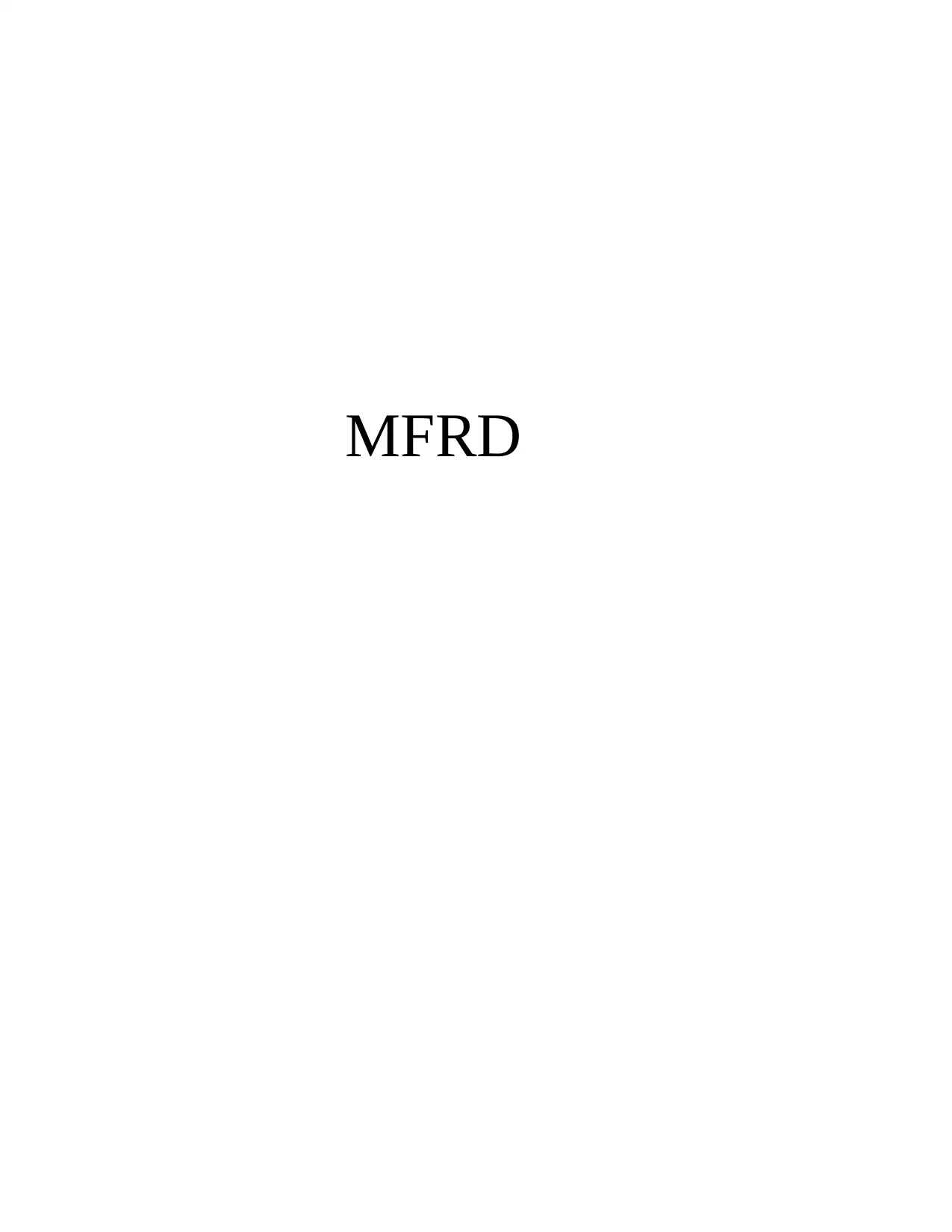
MFRD
Paraphrase This Document
Need a fresh take? Get an instant paraphrase of this document with our AI Paraphraser
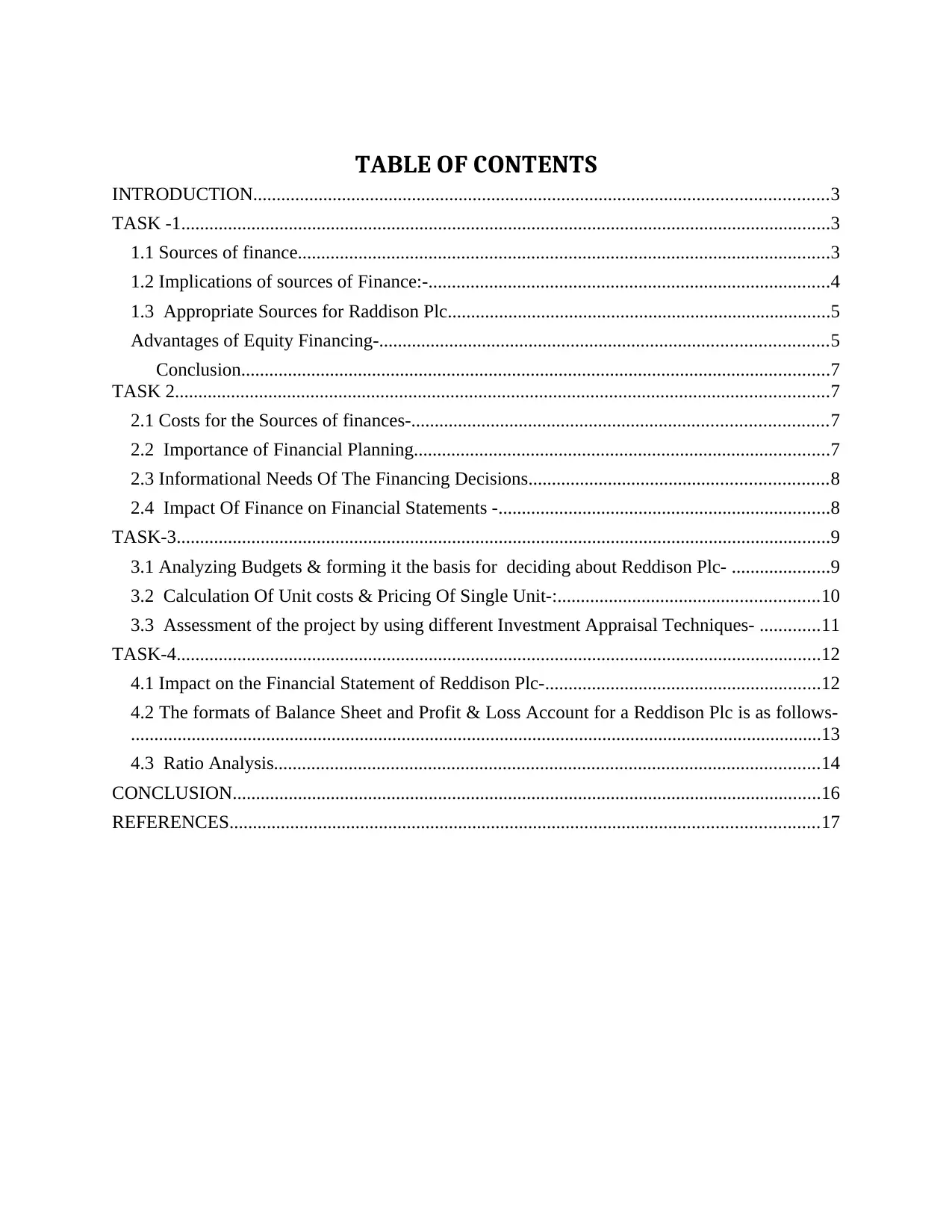
TABLE OF CONTENTS
INTRODUCTION...........................................................................................................................3
TASK -1...........................................................................................................................................3
1.1 Sources of finance..................................................................................................................3
1.2 Implications of sources of Finance:-......................................................................................4
1.3 Appropriate Sources for Raddison Plc..................................................................................5
Advantages of Equity Financing-................................................................................................5
Conclusion..............................................................................................................................7
TASK 2............................................................................................................................................7
2.1 Costs for the Sources of finances-.........................................................................................7
2.2 Importance of Financial Planning.........................................................................................7
2.3 Informational Needs Of The Financing Decisions................................................................8
2.4 Impact Of Finance on Financial Statements -.......................................................................8
TASK-3............................................................................................................................................9
3.1 Analyzing Budgets & forming it the basis for deciding about Reddison Plc- .....................9
3.2 Calculation Of Unit costs & Pricing Of Single Unit-:........................................................10
3.3 Assessment of the project by using different Investment Appraisal Techniques- .............11
TASK-4..........................................................................................................................................12
4.1 Impact on the Financial Statement of Reddison Plc-...........................................................12
4.2 The formats of Balance Sheet and Profit & Loss Account for a Reddison Plc is as follows-
....................................................................................................................................................13
4.3 Ratio Analysis.....................................................................................................................14
CONCLUSION..............................................................................................................................16
REFERENCES..............................................................................................................................17
INTRODUCTION...........................................................................................................................3
TASK -1...........................................................................................................................................3
1.1 Sources of finance..................................................................................................................3
1.2 Implications of sources of Finance:-......................................................................................4
1.3 Appropriate Sources for Raddison Plc..................................................................................5
Advantages of Equity Financing-................................................................................................5
Conclusion..............................................................................................................................7
TASK 2............................................................................................................................................7
2.1 Costs for the Sources of finances-.........................................................................................7
2.2 Importance of Financial Planning.........................................................................................7
2.3 Informational Needs Of The Financing Decisions................................................................8
2.4 Impact Of Finance on Financial Statements -.......................................................................8
TASK-3............................................................................................................................................9
3.1 Analyzing Budgets & forming it the basis for deciding about Reddison Plc- .....................9
3.2 Calculation Of Unit costs & Pricing Of Single Unit-:........................................................10
3.3 Assessment of the project by using different Investment Appraisal Techniques- .............11
TASK-4..........................................................................................................................................12
4.1 Impact on the Financial Statement of Reddison Plc-...........................................................12
4.2 The formats of Balance Sheet and Profit & Loss Account for a Reddison Plc is as follows-
....................................................................................................................................................13
4.3 Ratio Analysis.....................................................................................................................14
CONCLUSION..............................................................................................................................16
REFERENCES..............................................................................................................................17
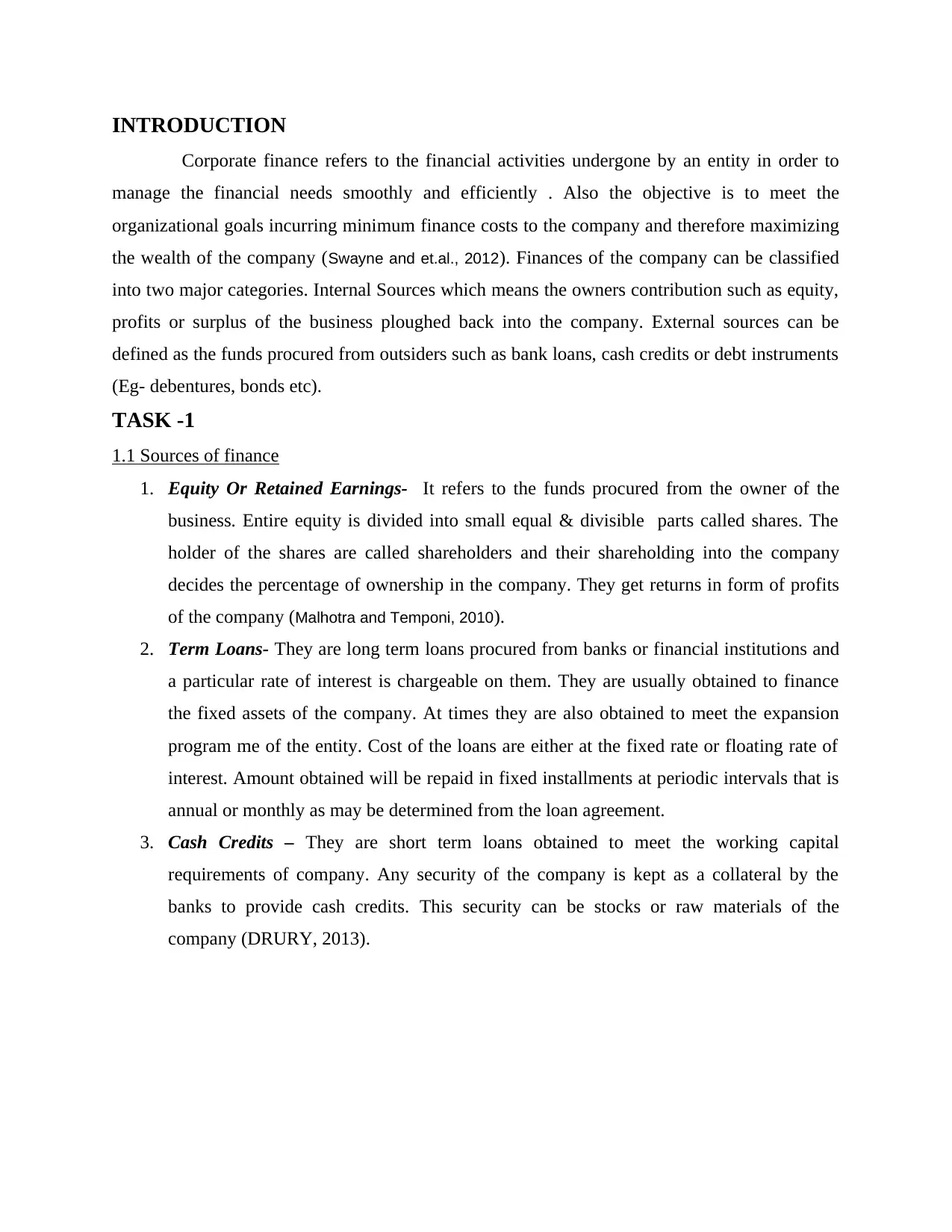
INTRODUCTION
Corporate finance refers to the financial activities undergone by an entity in order to
manage the financial needs smoothly and efficiently . Also the objective is to meet the
organizational goals incurring minimum finance costs to the company and therefore maximizing
the wealth of the company (Swayne and et.al., 2012). Finances of the company can be classified
into two major categories. Internal Sources which means the owners contribution such as equity,
profits or surplus of the business ploughed back into the company. External sources can be
defined as the funds procured from outsiders such as bank loans, cash credits or debt instruments
(Eg- debentures, bonds etc).
TASK -1
1.1 Sources of finance
1. Equity Or Retained Earnings- It refers to the funds procured from the owner of the
business. Entire equity is divided into small equal & divisible parts called shares. The
holder of the shares are called shareholders and their shareholding into the company
decides the percentage of ownership in the company. They get returns in form of profits
of the company (Malhotra and Temponi, 2010).
2. Term Loans- They are long term loans procured from banks or financial institutions and
a particular rate of interest is chargeable on them. They are usually obtained to finance
the fixed assets of the company. At times they are also obtained to meet the expansion
program me of the entity. Cost of the loans are either at the fixed rate or floating rate of
interest. Amount obtained will be repaid in fixed installments at periodic intervals that is
annual or monthly as may be determined from the loan agreement.
3. Cash Credits – They are short term loans obtained to meet the working capital
requirements of company. Any security of the company is kept as a collateral by the
banks to provide cash credits. This security can be stocks or raw materials of the
company (DRURY, 2013).
Corporate finance refers to the financial activities undergone by an entity in order to
manage the financial needs smoothly and efficiently . Also the objective is to meet the
organizational goals incurring minimum finance costs to the company and therefore maximizing
the wealth of the company (Swayne and et.al., 2012). Finances of the company can be classified
into two major categories. Internal Sources which means the owners contribution such as equity,
profits or surplus of the business ploughed back into the company. External sources can be
defined as the funds procured from outsiders such as bank loans, cash credits or debt instruments
(Eg- debentures, bonds etc).
TASK -1
1.1 Sources of finance
1. Equity Or Retained Earnings- It refers to the funds procured from the owner of the
business. Entire equity is divided into small equal & divisible parts called shares. The
holder of the shares are called shareholders and their shareholding into the company
decides the percentage of ownership in the company. They get returns in form of profits
of the company (Malhotra and Temponi, 2010).
2. Term Loans- They are long term loans procured from banks or financial institutions and
a particular rate of interest is chargeable on them. They are usually obtained to finance
the fixed assets of the company. At times they are also obtained to meet the expansion
program me of the entity. Cost of the loans are either at the fixed rate or floating rate of
interest. Amount obtained will be repaid in fixed installments at periodic intervals that is
annual or monthly as may be determined from the loan agreement.
3. Cash Credits – They are short term loans obtained to meet the working capital
requirements of company. Any security of the company is kept as a collateral by the
banks to provide cash credits. This security can be stocks or raw materials of the
company (DRURY, 2013).
⊘ This is a preview!⊘
Do you want full access?
Subscribe today to unlock all pages.

Trusted by 1+ million students worldwide
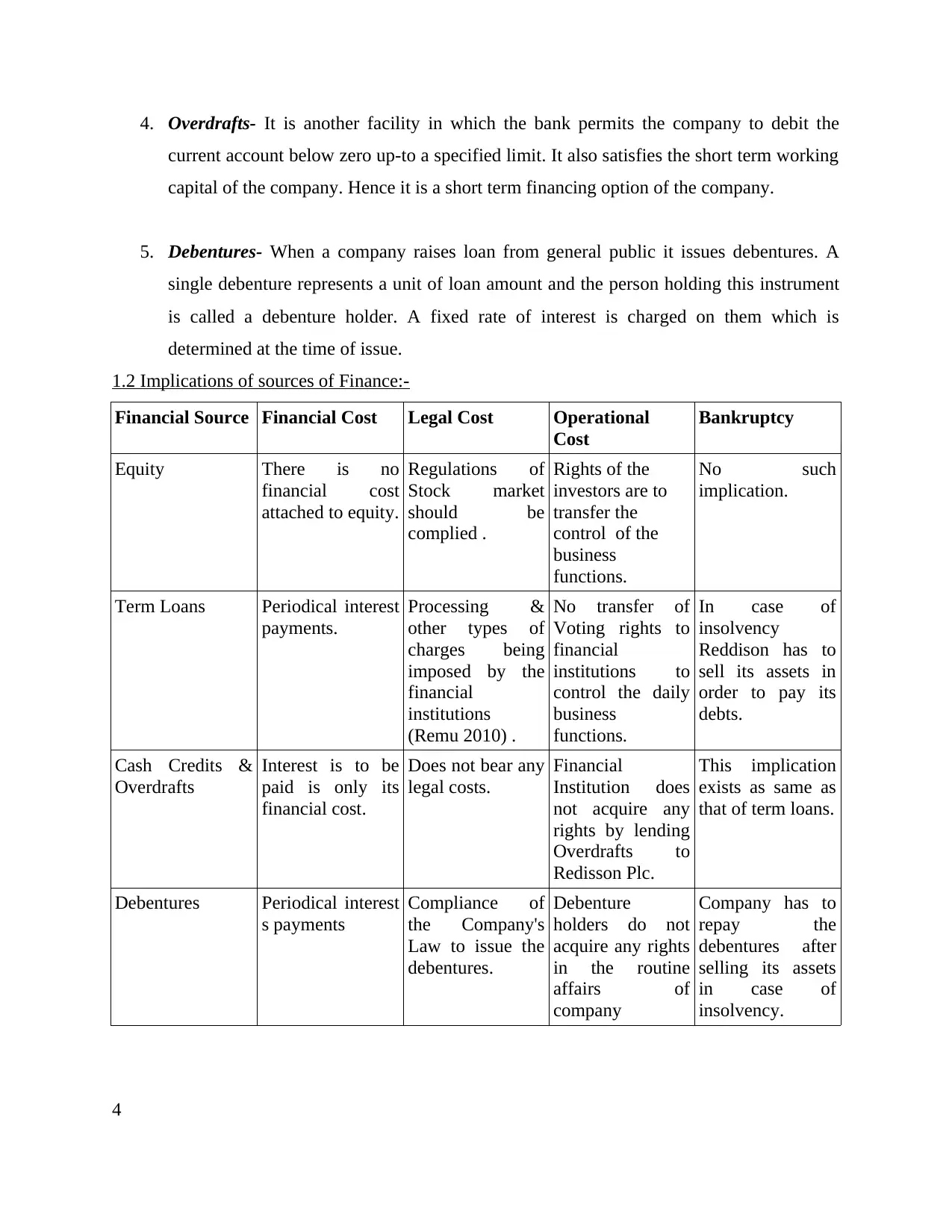
4. Overdrafts- It is another facility in which the bank permits the company to debit the
current account below zero up-to a specified limit. It also satisfies the short term working
capital of the company. Hence it is a short term financing option of the company.
5. Debentures- When a company raises loan from general public it issues debentures. A
single debenture represents a unit of loan amount and the person holding this instrument
is called a debenture holder. A fixed rate of interest is charged on them which is
determined at the time of issue.
1.2 Implications of sources of Finance:-
Financial Source Financial Cost Legal Cost Operational
Cost
Bankruptcy
Equity There is no
financial cost
attached to equity.
Regulations of
Stock market
should be
complied .
Rights of the
investors are to
transfer the
control of the
business
functions.
No such
implication.
Term Loans Periodical interest
payments.
Processing &
other types of
charges being
imposed by the
financial
institutions
(Remu 2010) .
No transfer of
Voting rights to
financial
institutions to
control the daily
business
functions.
In case of
insolvency
Reddison has to
sell its assets in
order to pay its
debts.
Cash Credits &
Overdrafts
Interest is to be
paid is only its
financial cost.
Does not bear any
legal costs.
Financial
Institution does
not acquire any
rights by lending
Overdrafts to
Redisson Plc.
This implication
exists as same as
that of term loans.
Debentures Periodical interest
s payments
Compliance of
the Company's
Law to issue the
debentures.
Debenture
holders do not
acquire any rights
in the routine
affairs of
company
Company has to
repay the
debentures after
selling its assets
in case of
insolvency.
4
current account below zero up-to a specified limit. It also satisfies the short term working
capital of the company. Hence it is a short term financing option of the company.
5. Debentures- When a company raises loan from general public it issues debentures. A
single debenture represents a unit of loan amount and the person holding this instrument
is called a debenture holder. A fixed rate of interest is charged on them which is
determined at the time of issue.
1.2 Implications of sources of Finance:-
Financial Source Financial Cost Legal Cost Operational
Cost
Bankruptcy
Equity There is no
financial cost
attached to equity.
Regulations of
Stock market
should be
complied .
Rights of the
investors are to
transfer the
control of the
business
functions.
No such
implication.
Term Loans Periodical interest
payments.
Processing &
other types of
charges being
imposed by the
financial
institutions
(Remu 2010) .
No transfer of
Voting rights to
financial
institutions to
control the daily
business
functions.
In case of
insolvency
Reddison has to
sell its assets in
order to pay its
debts.
Cash Credits &
Overdrafts
Interest is to be
paid is only its
financial cost.
Does not bear any
legal costs.
Financial
Institution does
not acquire any
rights by lending
Overdrafts to
Redisson Plc.
This implication
exists as same as
that of term loans.
Debentures Periodical interest
s payments
Compliance of
the Company's
Law to issue the
debentures.
Debenture
holders do not
acquire any rights
in the routine
affairs of
company
Company has to
repay the
debentures after
selling its assets
in case of
insolvency.
4
Paraphrase This Document
Need a fresh take? Get an instant paraphrase of this document with our AI Paraphraser
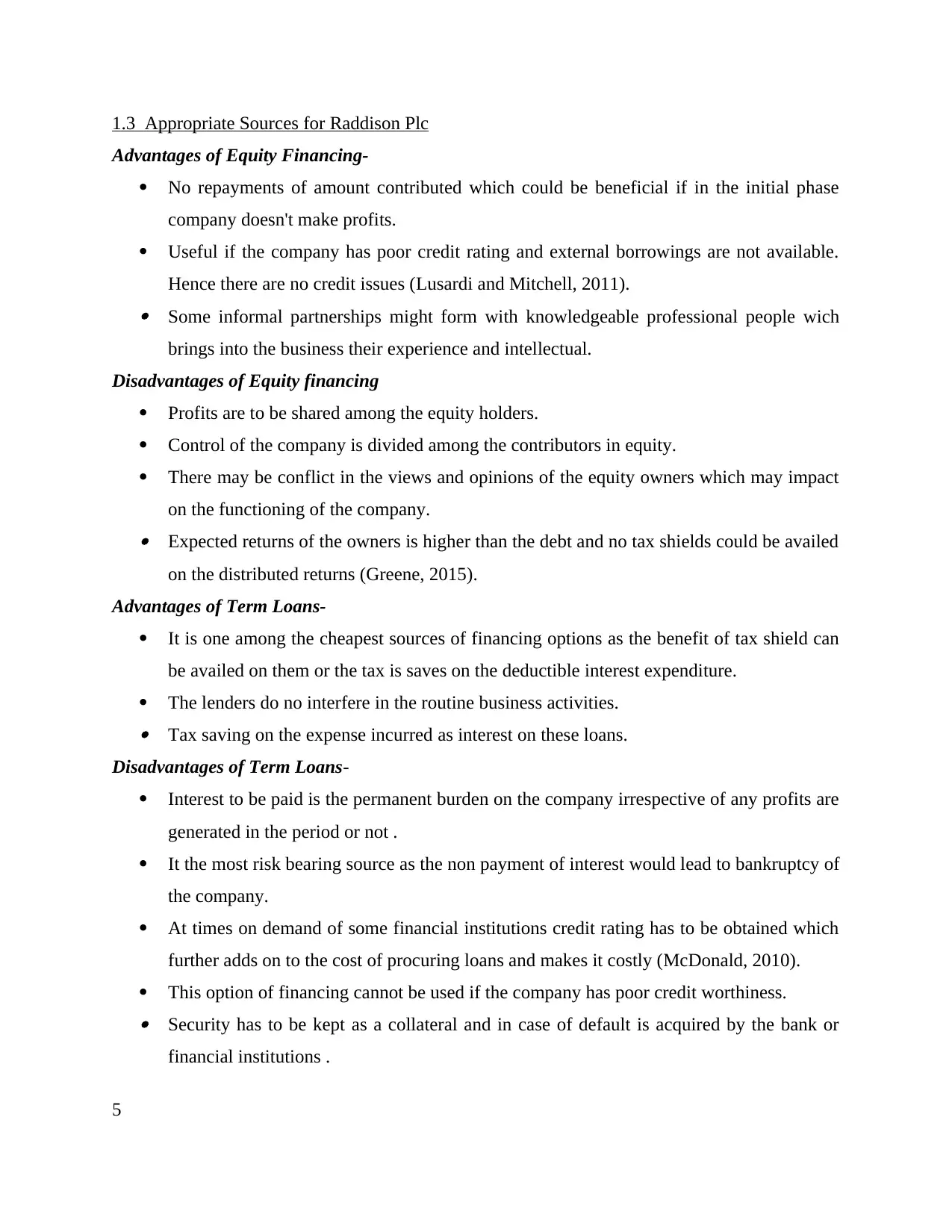
1.3 Appropriate Sources for Raddison Plc
Advantages of Equity Financing-
No repayments of amount contributed which could be beneficial if in the initial phase
company doesn't make profits.
Useful if the company has poor credit rating and external borrowings are not available.
Hence there are no credit issues (Lusardi and Mitchell, 2011). Some informal partnerships might form with knowledgeable professional people wich
brings into the business their experience and intellectual.
Disadvantages of Equity financing
Profits are to be shared among the equity holders.
Control of the company is divided among the contributors in equity.
There may be conflict in the views and opinions of the equity owners which may impact
on the functioning of the company. Expected returns of the owners is higher than the debt and no tax shields could be availed
on the distributed returns (Greene, 2015).
Advantages of Term Loans-
It is one among the cheapest sources of financing options as the benefit of tax shield can
be availed on them or the tax is saves on the deductible interest expenditure.
The lenders do no interfere in the routine business activities. Tax saving on the expense incurred as interest on these loans.
Disadvantages of Term Loans-
Interest to be paid is the permanent burden on the company irrespective of any profits are
generated in the period or not .
It the most risk bearing source as the non payment of interest would lead to bankruptcy of
the company.
At times on demand of some financial institutions credit rating has to be obtained which
further adds on to the cost of procuring loans and makes it costly (McDonald, 2010).
This option of financing cannot be used if the company has poor credit worthiness. Security has to be kept as a collateral and in case of default is acquired by the bank or
financial institutions .
5
Advantages of Equity Financing-
No repayments of amount contributed which could be beneficial if in the initial phase
company doesn't make profits.
Useful if the company has poor credit rating and external borrowings are not available.
Hence there are no credit issues (Lusardi and Mitchell, 2011). Some informal partnerships might form with knowledgeable professional people wich
brings into the business their experience and intellectual.
Disadvantages of Equity financing
Profits are to be shared among the equity holders.
Control of the company is divided among the contributors in equity.
There may be conflict in the views and opinions of the equity owners which may impact
on the functioning of the company. Expected returns of the owners is higher than the debt and no tax shields could be availed
on the distributed returns (Greene, 2015).
Advantages of Term Loans-
It is one among the cheapest sources of financing options as the benefit of tax shield can
be availed on them or the tax is saves on the deductible interest expenditure.
The lenders do no interfere in the routine business activities. Tax saving on the expense incurred as interest on these loans.
Disadvantages of Term Loans-
Interest to be paid is the permanent burden on the company irrespective of any profits are
generated in the period or not .
It the most risk bearing source as the non payment of interest would lead to bankruptcy of
the company.
At times on demand of some financial institutions credit rating has to be obtained which
further adds on to the cost of procuring loans and makes it costly (McDonald, 2010).
This option of financing cannot be used if the company has poor credit worthiness. Security has to be kept as a collateral and in case of default is acquired by the bank or
financial institutions .
5
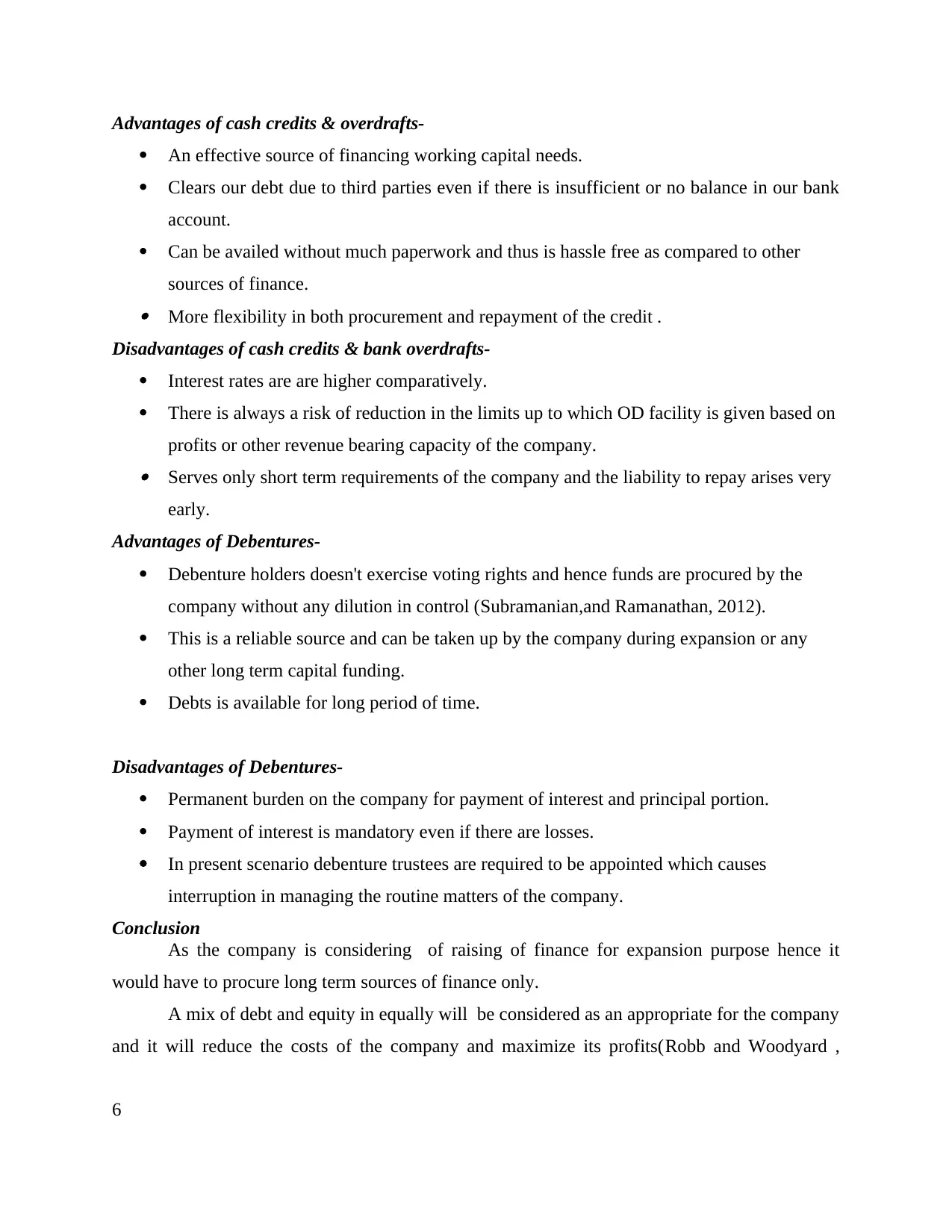
Advantages of cash credits & overdrafts-
An effective source of financing working capital needs.
Clears our debt due to third parties even if there is insufficient or no balance in our bank
account.
Can be availed without much paperwork and thus is hassle free as compared to other
sources of finance. More flexibility in both procurement and repayment of the credit .
Disadvantages of cash credits & bank overdrafts-
Interest rates are are higher comparatively.
There is always a risk of reduction in the limits up to which OD facility is given based on
profits or other revenue bearing capacity of the company. Serves only short term requirements of the company and the liability to repay arises very
early.
Advantages of Debentures-
Debenture holders doesn't exercise voting rights and hence funds are procured by the
company without any dilution in control (Subramanian,and Ramanathan, 2012).
This is a reliable source and can be taken up by the company during expansion or any
other long term capital funding.
Debts is available for long period of time.
Disadvantages of Debentures-
Permanent burden on the company for payment of interest and principal portion.
Payment of interest is mandatory even if there are losses.
In present scenario debenture trustees are required to be appointed which causes
interruption in managing the routine matters of the company.
Conclusion
As the company is considering of raising of finance for expansion purpose hence it
would have to procure long term sources of finance only.
A mix of debt and equity in equally will be considered as an appropriate for the company
and it will reduce the costs of the company and maximize its profits(Robb and Woodyard ,
6
An effective source of financing working capital needs.
Clears our debt due to third parties even if there is insufficient or no balance in our bank
account.
Can be availed without much paperwork and thus is hassle free as compared to other
sources of finance. More flexibility in both procurement and repayment of the credit .
Disadvantages of cash credits & bank overdrafts-
Interest rates are are higher comparatively.
There is always a risk of reduction in the limits up to which OD facility is given based on
profits or other revenue bearing capacity of the company. Serves only short term requirements of the company and the liability to repay arises very
early.
Advantages of Debentures-
Debenture holders doesn't exercise voting rights and hence funds are procured by the
company without any dilution in control (Subramanian,and Ramanathan, 2012).
This is a reliable source and can be taken up by the company during expansion or any
other long term capital funding.
Debts is available for long period of time.
Disadvantages of Debentures-
Permanent burden on the company for payment of interest and principal portion.
Payment of interest is mandatory even if there are losses.
In present scenario debenture trustees are required to be appointed which causes
interruption in managing the routine matters of the company.
Conclusion
As the company is considering of raising of finance for expansion purpose hence it
would have to procure long term sources of finance only.
A mix of debt and equity in equally will be considered as an appropriate for the company
and it will reduce the costs of the company and maximize its profits(Robb and Woodyard ,
6
⊘ This is a preview!⊘
Do you want full access?
Subscribe today to unlock all pages.

Trusted by 1+ million students worldwide
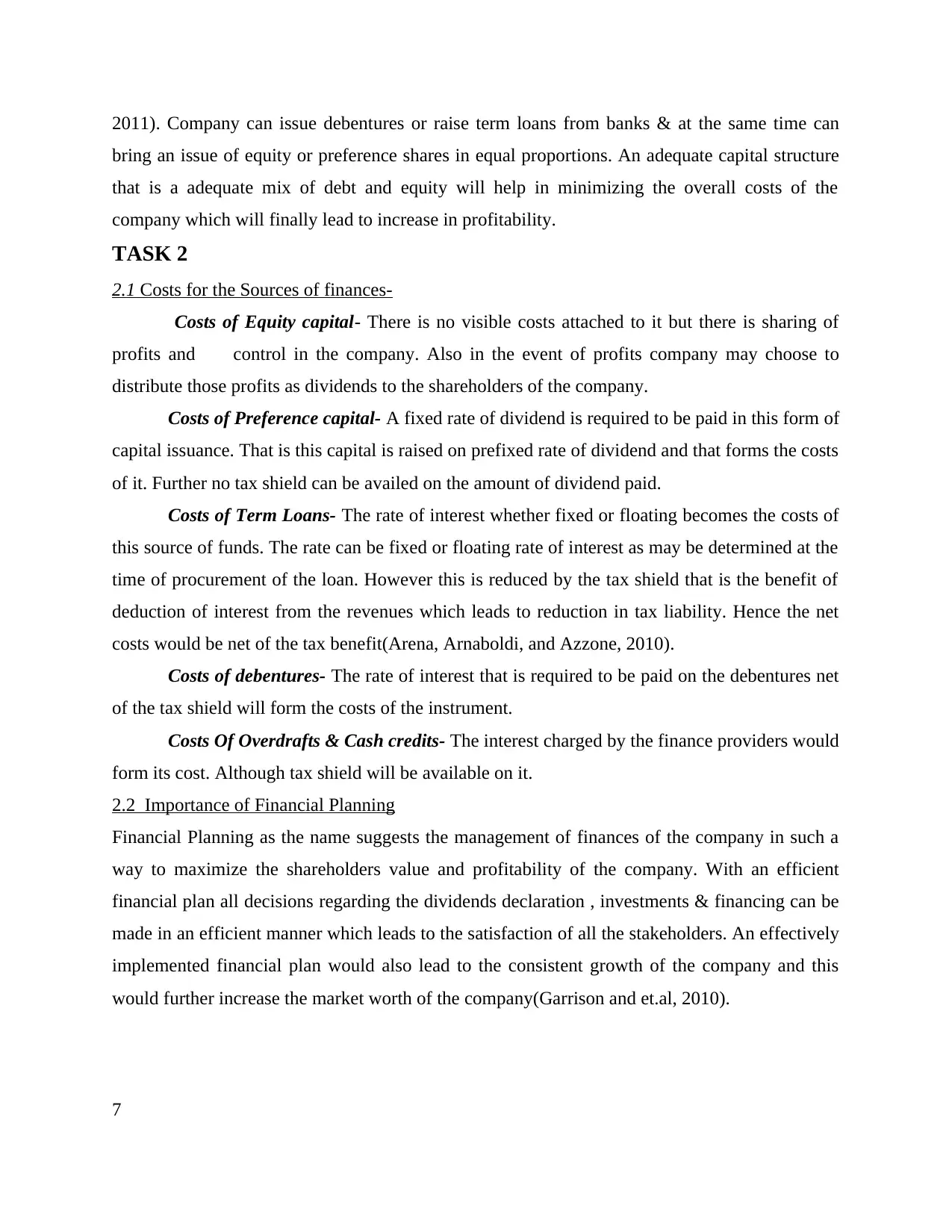
2011). Company can issue debentures or raise term loans from banks & at the same time can
bring an issue of equity or preference shares in equal proportions. An adequate capital structure
that is a adequate mix of debt and equity will help in minimizing the overall costs of the
company which will finally lead to increase in profitability.
TASK 2
2.1 Costs for the Sources of finances-
Costs of Equity capital- There is no visible costs attached to it but there is sharing of
profits and control in the company. Also in the event of profits company may choose to
distribute those profits as dividends to the shareholders of the company.
Costs of Preference capital- A fixed rate of dividend is required to be paid in this form of
capital issuance. That is this capital is raised on prefixed rate of dividend and that forms the costs
of it. Further no tax shield can be availed on the amount of dividend paid.
Costs of Term Loans- The rate of interest whether fixed or floating becomes the costs of
this source of funds. The rate can be fixed or floating rate of interest as may be determined at the
time of procurement of the loan. However this is reduced by the tax shield that is the benefit of
deduction of interest from the revenues which leads to reduction in tax liability. Hence the net
costs would be net of the tax benefit(Arena, Arnaboldi, and Azzone, 2010).
Costs of debentures- The rate of interest that is required to be paid on the debentures net
of the tax shield will form the costs of the instrument.
Costs Of Overdrafts & Cash credits- The interest charged by the finance providers would
form its cost. Although tax shield will be available on it.
2.2 Importance of Financial Planning
Financial Planning as the name suggests the management of finances of the company in such a
way to maximize the shareholders value and profitability of the company. With an efficient
financial plan all decisions regarding the dividends declaration , investments & financing can be
made in an efficient manner which leads to the satisfaction of all the stakeholders. An effectively
implemented financial plan would also lead to the consistent growth of the company and this
would further increase the market worth of the company(Garrison and et.al, 2010).
7
bring an issue of equity or preference shares in equal proportions. An adequate capital structure
that is a adequate mix of debt and equity will help in minimizing the overall costs of the
company which will finally lead to increase in profitability.
TASK 2
2.1 Costs for the Sources of finances-
Costs of Equity capital- There is no visible costs attached to it but there is sharing of
profits and control in the company. Also in the event of profits company may choose to
distribute those profits as dividends to the shareholders of the company.
Costs of Preference capital- A fixed rate of dividend is required to be paid in this form of
capital issuance. That is this capital is raised on prefixed rate of dividend and that forms the costs
of it. Further no tax shield can be availed on the amount of dividend paid.
Costs of Term Loans- The rate of interest whether fixed or floating becomes the costs of
this source of funds. The rate can be fixed or floating rate of interest as may be determined at the
time of procurement of the loan. However this is reduced by the tax shield that is the benefit of
deduction of interest from the revenues which leads to reduction in tax liability. Hence the net
costs would be net of the tax benefit(Arena, Arnaboldi, and Azzone, 2010).
Costs of debentures- The rate of interest that is required to be paid on the debentures net
of the tax shield will form the costs of the instrument.
Costs Of Overdrafts & Cash credits- The interest charged by the finance providers would
form its cost. Although tax shield will be available on it.
2.2 Importance of Financial Planning
Financial Planning as the name suggests the management of finances of the company in such a
way to maximize the shareholders value and profitability of the company. With an efficient
financial plan all decisions regarding the dividends declaration , investments & financing can be
made in an efficient manner which leads to the satisfaction of all the stakeholders. An effectively
implemented financial plan would also lead to the consistent growth of the company and this
would further increase the market worth of the company(Garrison and et.al, 2010).
7
Paraphrase This Document
Need a fresh take? Get an instant paraphrase of this document with our AI Paraphraser
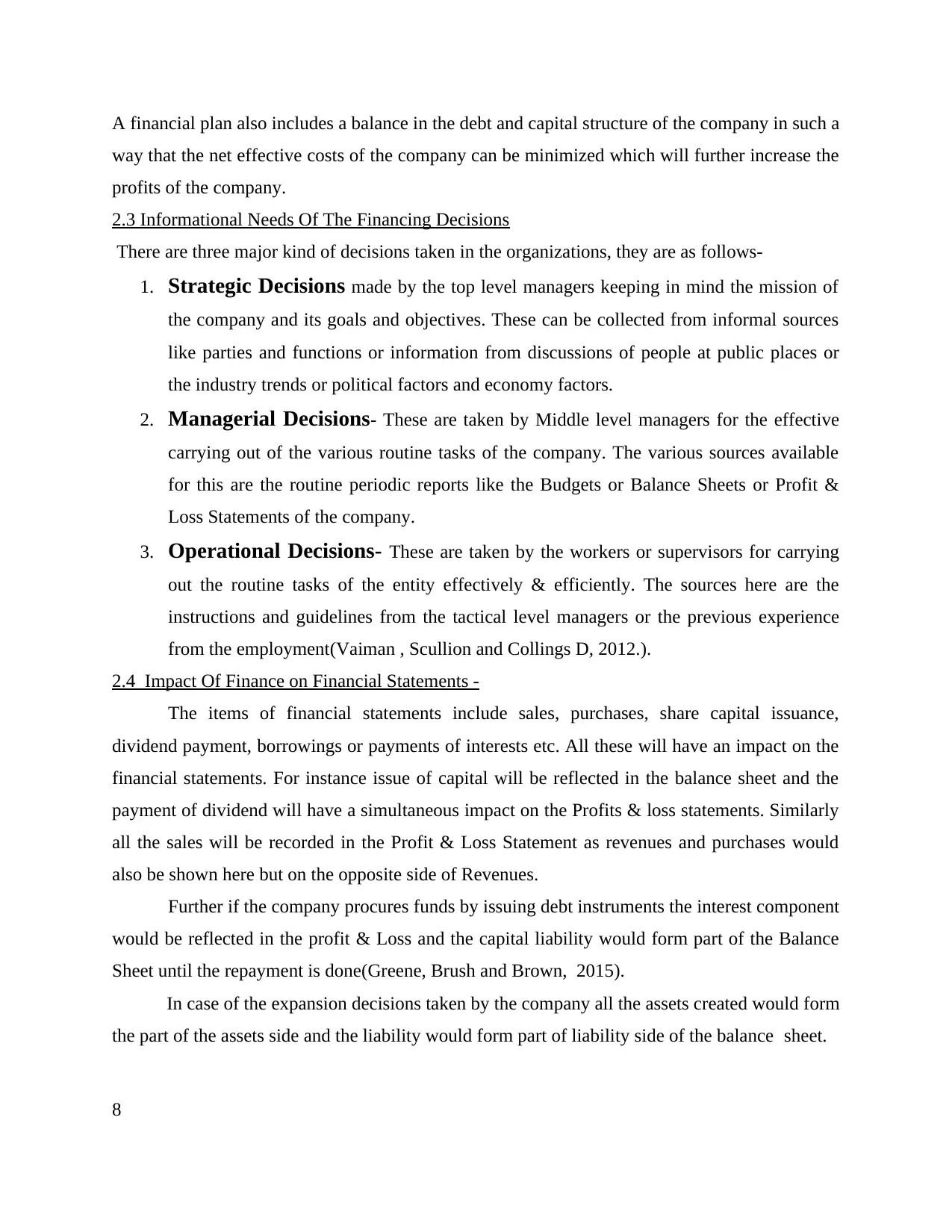
A financial plan also includes a balance in the debt and capital structure of the company in such a
way that the net effective costs of the company can be minimized which will further increase the
profits of the company.
2.3 Informational Needs Of The Financing Decisions
There are three major kind of decisions taken in the organizations, they are as follows-
1. Strategic Decisions made by the top level managers keeping in mind the mission of
the company and its goals and objectives. These can be collected from informal sources
like parties and functions or information from discussions of people at public places or
the industry trends or political factors and economy factors.
2. Managerial Decisions- These are taken by Middle level managers for the effective
carrying out of the various routine tasks of the company. The various sources available
for this are the routine periodic reports like the Budgets or Balance Sheets or Profit &
Loss Statements of the company.
3. Operational Decisions- These are taken by the workers or supervisors for carrying
out the routine tasks of the entity effectively & efficiently. The sources here are the
instructions and guidelines from the tactical level managers or the previous experience
from the employment(Vaiman , Scullion and Collings D, 2012.).
2.4 Impact Of Finance on Financial Statements -
The items of financial statements include sales, purchases, share capital issuance,
dividend payment, borrowings or payments of interests etc. All these will have an impact on the
financial statements. For instance issue of capital will be reflected in the balance sheet and the
payment of dividend will have a simultaneous impact on the Profits & loss statements. Similarly
all the sales will be recorded in the Profit & Loss Statement as revenues and purchases would
also be shown here but on the opposite side of Revenues.
Further if the company procures funds by issuing debt instruments the interest component
would be reflected in the profit & Loss and the capital liability would form part of the Balance
Sheet until the repayment is done(Greene, Brush and Brown, 2015).
In case of the expansion decisions taken by the company all the assets created would form
the part of the assets side and the liability would form part of liability side of the balance sheet.
8
way that the net effective costs of the company can be minimized which will further increase the
profits of the company.
2.3 Informational Needs Of The Financing Decisions
There are three major kind of decisions taken in the organizations, they are as follows-
1. Strategic Decisions made by the top level managers keeping in mind the mission of
the company and its goals and objectives. These can be collected from informal sources
like parties and functions or information from discussions of people at public places or
the industry trends or political factors and economy factors.
2. Managerial Decisions- These are taken by Middle level managers for the effective
carrying out of the various routine tasks of the company. The various sources available
for this are the routine periodic reports like the Budgets or Balance Sheets or Profit &
Loss Statements of the company.
3. Operational Decisions- These are taken by the workers or supervisors for carrying
out the routine tasks of the entity effectively & efficiently. The sources here are the
instructions and guidelines from the tactical level managers or the previous experience
from the employment(Vaiman , Scullion and Collings D, 2012.).
2.4 Impact Of Finance on Financial Statements -
The items of financial statements include sales, purchases, share capital issuance,
dividend payment, borrowings or payments of interests etc. All these will have an impact on the
financial statements. For instance issue of capital will be reflected in the balance sheet and the
payment of dividend will have a simultaneous impact on the Profits & loss statements. Similarly
all the sales will be recorded in the Profit & Loss Statement as revenues and purchases would
also be shown here but on the opposite side of Revenues.
Further if the company procures funds by issuing debt instruments the interest component
would be reflected in the profit & Loss and the capital liability would form part of the Balance
Sheet until the repayment is done(Greene, Brush and Brown, 2015).
In case of the expansion decisions taken by the company all the assets created would form
the part of the assets side and the liability would form part of liability side of the balance sheet.
8
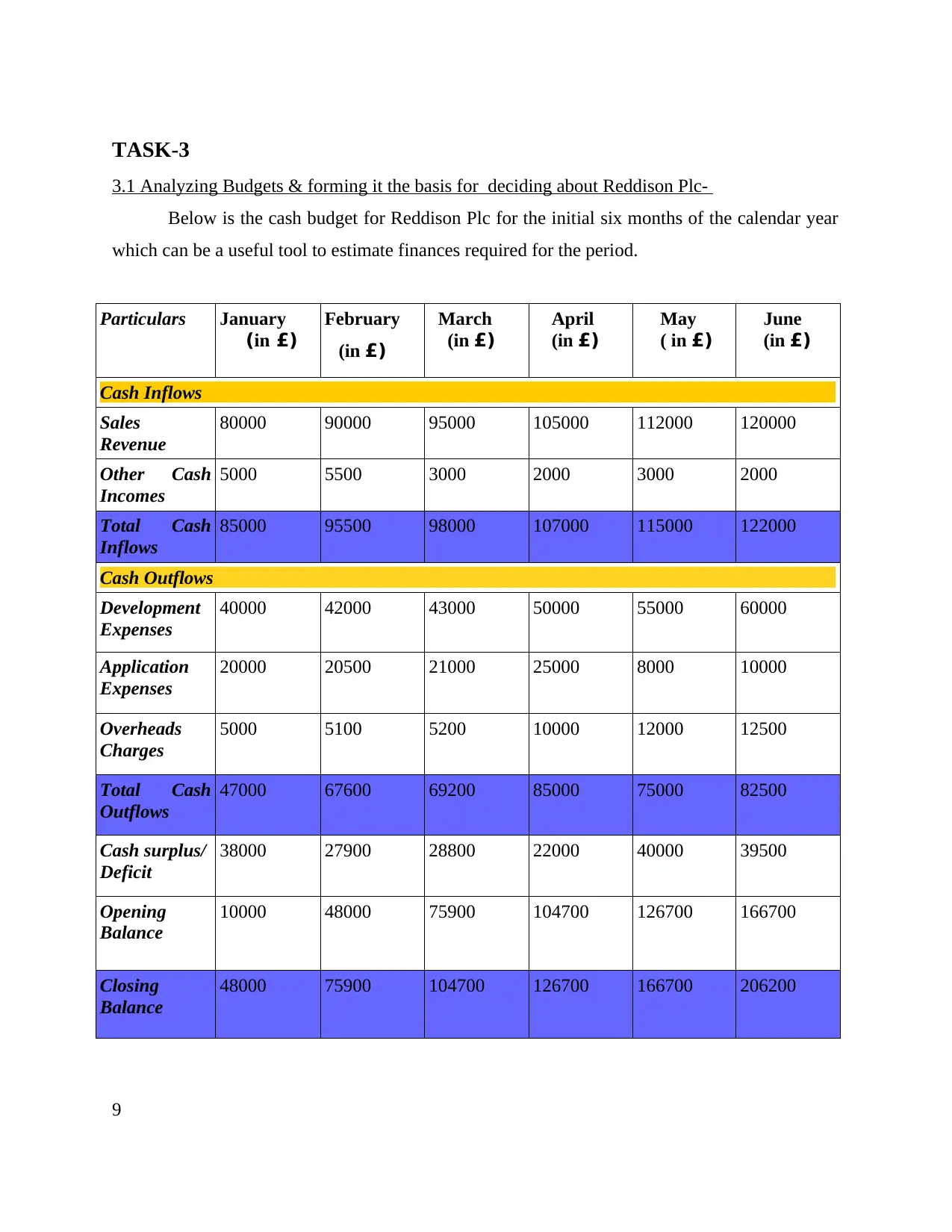
TASK-3
3.1 Analyzing Budgets & forming it the basis for deciding about Reddison Plc-
Below is the cash budget for Reddison Plc for the initial six months of the calendar year
which can be a useful tool to estimate finances required for the period.
Particulars January
(in £)
February
(in £)
March
(in £)
April
(in £)
May
( in £)
June
(in £)
Cash Inflows
Sales
Revenue
80000 90000 95000 105000 112000 120000
Other Cash
Incomes
5000 5500 3000 2000 3000 2000
Total Cash
Inflows
85000 95500 98000 107000 115000 122000
Cash Outflows
Development
Expenses
40000 42000 43000 50000 55000 60000
Application
Expenses
20000 20500 21000 25000 8000 10000
Overheads
Charges
5000 5100 5200 10000 12000 12500
Total Cash
Outflows
47000 67600 69200 85000 75000 82500
Cash surplus/
Deficit
38000 27900 28800 22000 40000 39500
Opening
Balance
10000 48000 75900 104700 126700 166700
Closing
Balance
48000 75900 104700 126700 166700 206200
9
3.1 Analyzing Budgets & forming it the basis for deciding about Reddison Plc-
Below is the cash budget for Reddison Plc for the initial six months of the calendar year
which can be a useful tool to estimate finances required for the period.
Particulars January
(in £)
February
(in £)
March
(in £)
April
(in £)
May
( in £)
June
(in £)
Cash Inflows
Sales
Revenue
80000 90000 95000 105000 112000 120000
Other Cash
Incomes
5000 5500 3000 2000 3000 2000
Total Cash
Inflows
85000 95500 98000 107000 115000 122000
Cash Outflows
Development
Expenses
40000 42000 43000 50000 55000 60000
Application
Expenses
20000 20500 21000 25000 8000 10000
Overheads
Charges
5000 5100 5200 10000 12000 12500
Total Cash
Outflows
47000 67600 69200 85000 75000 82500
Cash surplus/
Deficit
38000 27900 28800 22000 40000 39500
Opening
Balance
10000 48000 75900 104700 126700 166700
Closing
Balance
48000 75900 104700 126700 166700 206200
9
⊘ This is a preview!⊘
Do you want full access?
Subscribe today to unlock all pages.

Trusted by 1+ million students worldwide
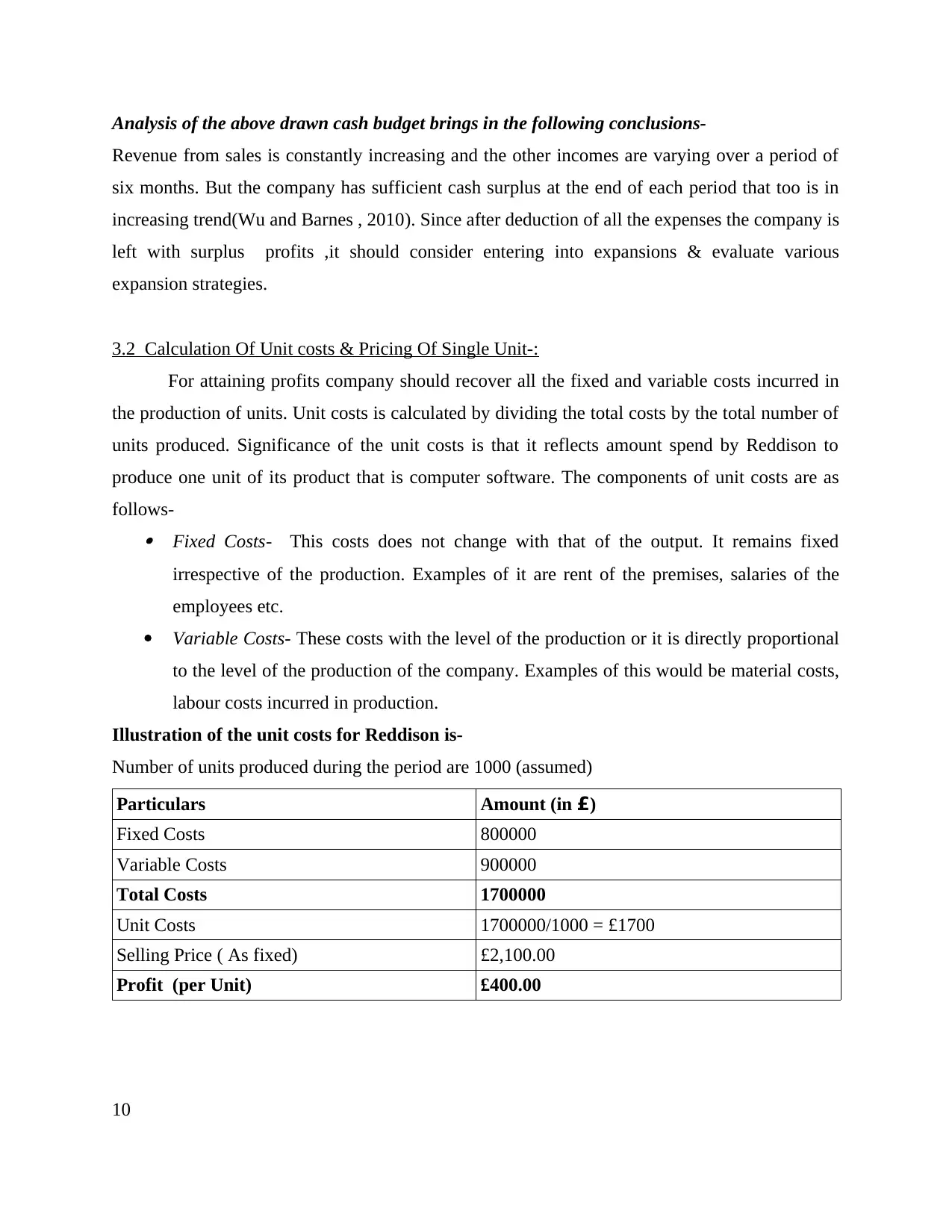
Analysis of the above drawn cash budget brings in the following conclusions-
Revenue from sales is constantly increasing and the other incomes are varying over a period of
six months. But the company has sufficient cash surplus at the end of each period that too is in
increasing trend(Wu and Barnes , 2010). Since after deduction of all the expenses the company is
left with surplus profits ,it should consider entering into expansions & evaluate various
expansion strategies.
3.2 Calculation Of Unit costs & Pricing Of Single Unit-:
For attaining profits company should recover all the fixed and variable costs incurred in
the production of units. Unit costs is calculated by dividing the total costs by the total number of
units produced. Significance of the unit costs is that it reflects amount spend by Reddison to
produce one unit of its product that is computer software. The components of unit costs are as
follows- Fixed Costs- This costs does not change with that of the output. It remains fixed
irrespective of the production. Examples of it are rent of the premises, salaries of the
employees etc.
Variable Costs- These costs with the level of the production or it is directly proportional
to the level of the production of the company. Examples of this would be material costs,
labour costs incurred in production.
Illustration of the unit costs for Reddison is-
Number of units produced during the period are 1000 (assumed)
Particulars Amount (in £)
Fixed Costs 800000
Variable Costs 900000
Total Costs 1700000
Unit Costs 1700000/1000 = £1700
Selling Price ( As fixed) £2,100.00
Profit (per Unit) £400.00
10
Revenue from sales is constantly increasing and the other incomes are varying over a period of
six months. But the company has sufficient cash surplus at the end of each period that too is in
increasing trend(Wu and Barnes , 2010). Since after deduction of all the expenses the company is
left with surplus profits ,it should consider entering into expansions & evaluate various
expansion strategies.
3.2 Calculation Of Unit costs & Pricing Of Single Unit-:
For attaining profits company should recover all the fixed and variable costs incurred in
the production of units. Unit costs is calculated by dividing the total costs by the total number of
units produced. Significance of the unit costs is that it reflects amount spend by Reddison to
produce one unit of its product that is computer software. The components of unit costs are as
follows- Fixed Costs- This costs does not change with that of the output. It remains fixed
irrespective of the production. Examples of it are rent of the premises, salaries of the
employees etc.
Variable Costs- These costs with the level of the production or it is directly proportional
to the level of the production of the company. Examples of this would be material costs,
labour costs incurred in production.
Illustration of the unit costs for Reddison is-
Number of units produced during the period are 1000 (assumed)
Particulars Amount (in £)
Fixed Costs 800000
Variable Costs 900000
Total Costs 1700000
Unit Costs 1700000/1000 = £1700
Selling Price ( As fixed) £2,100.00
Profit (per Unit) £400.00
10
Paraphrase This Document
Need a fresh take? Get an instant paraphrase of this document with our AI Paraphraser
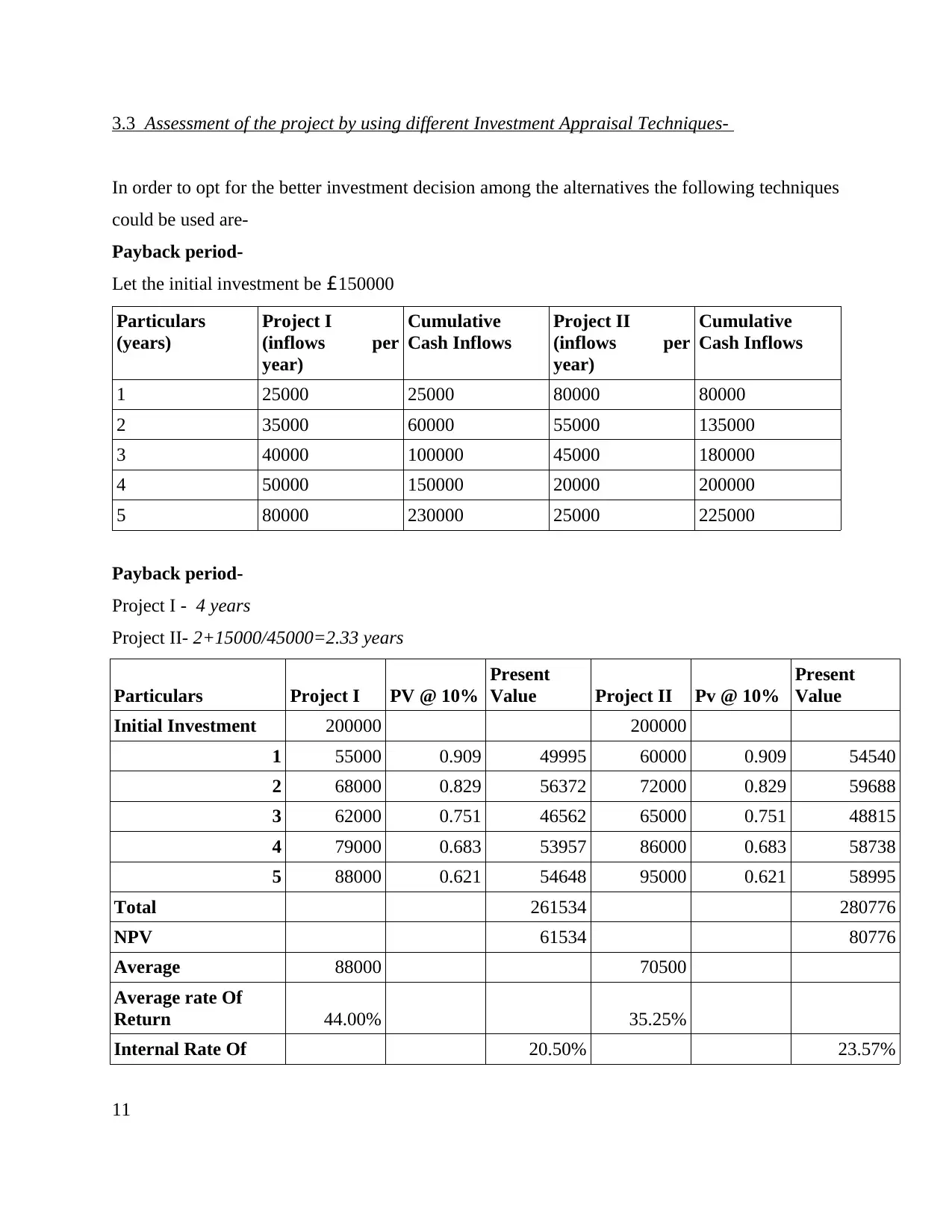
3.3 Assessment of the project by using different Investment Appraisal Techniques-
In order to opt for the better investment decision among the alternatives the following techniques
could be used are-
Payback period-
Let the initial investment be £150000
Particulars
(years)
Project I
(inflows per
year)
Cumulative
Cash Inflows
Project II
(inflows per
year)
Cumulative
Cash Inflows
1 25000 25000 80000 80000
2 35000 60000 55000 135000
3 40000 100000 45000 180000
4 50000 150000 20000 200000
5 80000 230000 25000 225000
Payback period-
Project I - 4 years
Project II- 2+15000/45000=2.33 years
Particulars Project I PV @ 10%
Present
Value Project II Pv @ 10%
Present
Value
Initial Investment 200000 200000
1 55000 0.909 49995 60000 0.909 54540
2 68000 0.829 56372 72000 0.829 59688
3 62000 0.751 46562 65000 0.751 48815
4 79000 0.683 53957 86000 0.683 58738
5 88000 0.621 54648 95000 0.621 58995
Total 261534 280776
NPV 61534 80776
Average 88000 70500
Average rate Of
Return 44.00% 35.25%
Internal Rate Of 20.50% 23.57%
11
In order to opt for the better investment decision among the alternatives the following techniques
could be used are-
Payback period-
Let the initial investment be £150000
Particulars
(years)
Project I
(inflows per
year)
Cumulative
Cash Inflows
Project II
(inflows per
year)
Cumulative
Cash Inflows
1 25000 25000 80000 80000
2 35000 60000 55000 135000
3 40000 100000 45000 180000
4 50000 150000 20000 200000
5 80000 230000 25000 225000
Payback period-
Project I - 4 years
Project II- 2+15000/45000=2.33 years
Particulars Project I PV @ 10%
Present
Value Project II Pv @ 10%
Present
Value
Initial Investment 200000 200000
1 55000 0.909 49995 60000 0.909 54540
2 68000 0.829 56372 72000 0.829 59688
3 62000 0.751 46562 65000 0.751 48815
4 79000 0.683 53957 86000 0.683 58738
5 88000 0.621 54648 95000 0.621 58995
Total 261534 280776
NPV 61534 80776
Average 88000 70500
Average rate Of
Return 44.00% 35.25%
Internal Rate Of 20.50% 23.57%
11
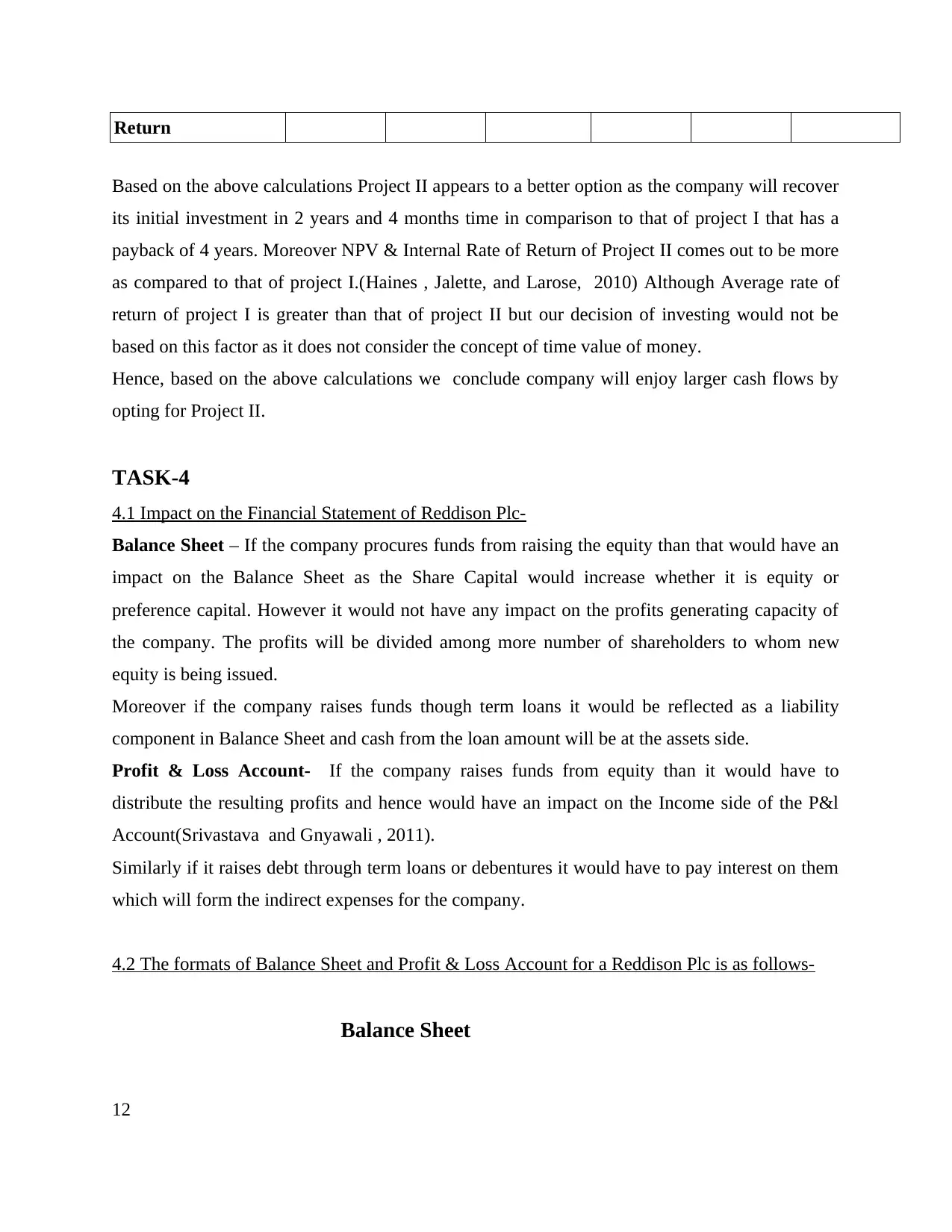
Return
Based on the above calculations Project II appears to a better option as the company will recover
its initial investment in 2 years and 4 months time in comparison to that of project I that has a
payback of 4 years. Moreover NPV & Internal Rate of Return of Project II comes out to be more
as compared to that of project I.(Haines , Jalette, and Larose, 2010) Although Average rate of
return of project I is greater than that of project II but our decision of investing would not be
based on this factor as it does not consider the concept of time value of money.
Hence, based on the above calculations we conclude company will enjoy larger cash flows by
opting for Project II.
TASK-4
4.1 Impact on the Financial Statement of Reddison Plc-
Balance Sheet – If the company procures funds from raising the equity than that would have an
impact on the Balance Sheet as the Share Capital would increase whether it is equity or
preference capital. However it would not have any impact on the profits generating capacity of
the company. The profits will be divided among more number of shareholders to whom new
equity is being issued.
Moreover if the company raises funds though term loans it would be reflected as a liability
component in Balance Sheet and cash from the loan amount will be at the assets side.
Profit & Loss Account- If the company raises funds from equity than it would have to
distribute the resulting profits and hence would have an impact on the Income side of the P&l
Account(Srivastava and Gnyawali , 2011).
Similarly if it raises debt through term loans or debentures it would have to pay interest on them
which will form the indirect expenses for the company.
4.2 The formats of Balance Sheet and Profit & Loss Account for a Reddison Plc is as follows-
Balance Sheet
12
Based on the above calculations Project II appears to a better option as the company will recover
its initial investment in 2 years and 4 months time in comparison to that of project I that has a
payback of 4 years. Moreover NPV & Internal Rate of Return of Project II comes out to be more
as compared to that of project I.(Haines , Jalette, and Larose, 2010) Although Average rate of
return of project I is greater than that of project II but our decision of investing would not be
based on this factor as it does not consider the concept of time value of money.
Hence, based on the above calculations we conclude company will enjoy larger cash flows by
opting for Project II.
TASK-4
4.1 Impact on the Financial Statement of Reddison Plc-
Balance Sheet – If the company procures funds from raising the equity than that would have an
impact on the Balance Sheet as the Share Capital would increase whether it is equity or
preference capital. However it would not have any impact on the profits generating capacity of
the company. The profits will be divided among more number of shareholders to whom new
equity is being issued.
Moreover if the company raises funds though term loans it would be reflected as a liability
component in Balance Sheet and cash from the loan amount will be at the assets side.
Profit & Loss Account- If the company raises funds from equity than it would have to
distribute the resulting profits and hence would have an impact on the Income side of the P&l
Account(Srivastava and Gnyawali , 2011).
Similarly if it raises debt through term loans or debentures it would have to pay interest on them
which will form the indirect expenses for the company.
4.2 The formats of Balance Sheet and Profit & Loss Account for a Reddison Plc is as follows-
Balance Sheet
12
⊘ This is a preview!⊘
Do you want full access?
Subscribe today to unlock all pages.

Trusted by 1+ million students worldwide
1 out of 18
Related Documents
Your All-in-One AI-Powered Toolkit for Academic Success.
+13062052269
info@desklib.com
Available 24*7 on WhatsApp / Email
![[object Object]](/_next/static/media/star-bottom.7253800d.svg)
Unlock your academic potential
Copyright © 2020–2025 A2Z Services. All Rights Reserved. Developed and managed by ZUCOL.





